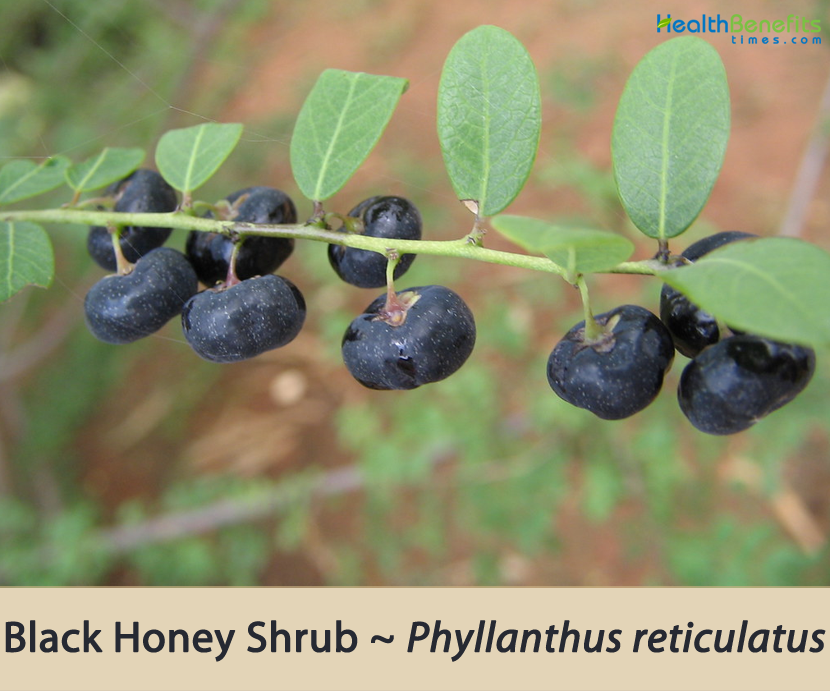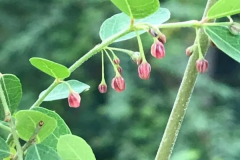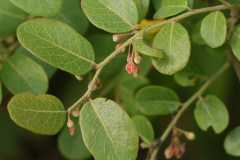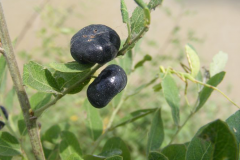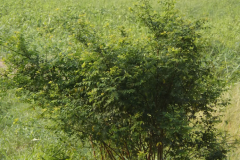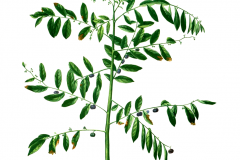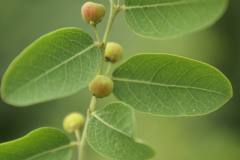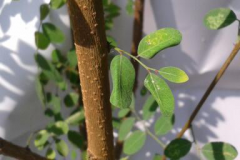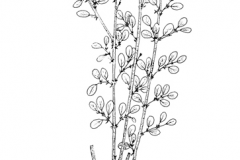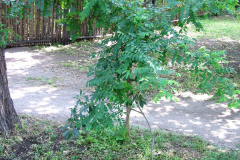The genus name Phyllanthus is based on the Greek word meaning leaf flower (phyll – leaf and anthus – flower); because in some species of the genus the flowers are produced at the edges of leaf-like branches. The species name reticulatus means nettled and refers to the netting of the leaves. This is an Asian species of Phyllanthus (but it was also introduced to Jamaica) and has been confused with P. polyspermus. In Vietnamese its name is phèn đen (sometimes diệp hạ châu mạng). It is also found in Northern Australia, where the aborigines of the Moyle River area use the wood for fire sticks and call it Mirriny mirriny. It is a multipurpose plant, providing a range of medicinal uses and other commodities for the local people, as well as a possibly edible fruit. The fruit is occasionally sold in local markets. The root bark, stem bark and leaves are collected from the wild and traded in local markets.
Black honey shrub Facts
| Black honey shrub Quick Facts | |
|---|---|
| Name: | Black honey shrub |
| Scientific Name: | Phyllanthus reticulatus |
| Origin | Old World tropics, from tropical Africa to India, Pakistan, Sri Lanka, Burma (Myanmar), Indo-China, southern China, Thailand and South-East Asia, and south to Queensland (northern Australia). |
| Colors | Initially green turning to bluish black when ripe |
| Shapes | Very small, roundish, depressed-globose berry like fruits about 4-6 mm in diameter |
| Flesh colors | Dark purplish pulp |
| Taste | Sweet, Astringent |
| Health benefits | Good for malaria, diabetes, polio, measles, asthma, sore throat, snake bites, conjunctivitis, anemia, eye diseases, sores, burns, gum bleeding, muscle spasms, worms, headaches, and abscesses |
| Name | Black honey shrub |
|---|---|
| Scientific Name | Phyllanthus reticulatus |
| Native | Old World tropics, from tropical Africa to India, Pakistan, Sri Lanka, Burma (Myanmar), Indo-China, southern China, Thailand and South-East Asia, and south to Queensland (northern Australia). It has been introduced into the West Indies. It occurs throughout tropical Africa, except in the most humid, equatorial areas, and also in Egypt and northern South Africa |
| Common Names | Black-honey shrub, Reticulated leaf-flower, Black-berried feather foil, Potato-bush, Netted-leaved leaf-flower, Neernelli, Potato plant, Potato smell, Inki pazham, Neeroli |
| Name in Other Languages | Afrikaans: Aartappelbos, Alambu, Filakoke, Dibribi, Nkokobro Assamese: Amlakhi (আম্লখি), Bon-amlokhi, Mon-chini Bengali: Panjuli Cambodia: Prâpéénh chhmôôl Chinese: Xiao guo ye xia zhu (小果葉下珠 ), Mìgān cǎo (蜜柑草), Wú máo xiǎo guǒ yè xià zhū (wú máo lóng yǎnjīng) (无毛小果叶下珠 (无毛龙眼睛) English: Black-berried featherfoil, Black-honey shrub, Potato-bush, Netted-leaved leaf-flower Finnish: Jokilaipikka Gujarati: Kamboi (કંબોઈ) Hindi: Kale madh ka per (काले मध का पेड़ ), Makhi (माषी ), Panjuli (पाणजुळी), Pancoli, Krishna kamboji, Puli chettu, Makkhi (मक्खी) Indonesia: Wawulutan, trembilu, congcong belut Japanese: Shimakoban’noki (シマコバンノキ), Shima komi kansou Javanese: Woh mangsi Kannada: Karihuli (ಕರಿಹುಳಿ), Pulaverii, Anamsule Konkani: Panpoi (पानपोय) Laos: Am ai, kangpa Malayalam: Nirnelli (നീര്നെല്ലി), nīrēāli ceṭi (നീരോലി ചെടി), Niruri, Nireli, Kattuniruri, Kilanelli, Neeroli, Poolanchedy Malaysia: Tampal besi, kayu darah belut Marathi: Panjuli (पाणजुळी), Panpoi (पानपोई ), Pavari (पवारी), Pavana Oriya: Phajoli, bala datun, bonoti-hudi, jandaki, jojangi, phajoli Philippines: Malatinta, matang-buiud, sungot-olang Punjabi: Panjuli Sango: Nziä Sanskrit: Krishna kamboji (कृष्ण काम्बोजी), Pulika, Krishna-kamboji Tamil: Civappuppula (சிவப்புப்பூலா), Karunelli (கருநெல்லி ), Karuvilangi, Kattukkilanelli (காட்டுக்கீழாநெல்லி), pula (பூலா), Karuvilangi, Abaranji, Karunelli, Kattukilanelli, Soolaketti Telugu: Nallapuli (నల్లపూలి ) Thailand: Kaang plaa khruea, mat kham, am aai Vietnamese: Phèn đen, Diệp hạ châu mạng, Cây no, Kỏ kang pá |
| Plant Growth Habit | Erect or somewhat climbing, dense, quick-growing, deciduous, many-branched shrub or small bushy tree |
| Growing Climates | Grows along watercourses, in scrub and hedges, on waste places, in mixed evergreen forest, thickets, roadside, boundary of pond, stream banks, lake shores, in moist deciduous and semi-evergreen forests, forested areas, open places, floodplain grassland, sand dune scrub, littoral scrub, dune forest, rain-forest occasionally on termitaria, miombo woodlands and often beside seasonal rivers and streams |
| Soil | Grows best in deep moist soil, but can also tolerate sandy but not too dry conditions. This plant is best planted together with other taller bushes where it can scramble |
| Plant Size | Up to 1.5 to 5 meters tall (in Africa rarely up to 18 m tall). Trunk up to 15 cm in diameter |
| Stem | Stem has small, downy hairs when it is young, and becomes hairless when they mature |
| Bark | Bark is light reddish-brown or grey-brown with hairy stems when young, which become smooth with age. |
| Leaf | Leaves are green, ovate-oblong to elliptic, 3-5 cm long and 2-3 cm wide produced on short lateral branchlets, looking like leaflets of a compound leaf with a smooth upper surface and a prominent midrib |
| Flowering season | September to October |
| Flower | Small about 1-1.5mm long, greenish-yellow flowers with a reddish tinge. One female and a number of male flowers are grouped together. male flowers with 5(-6) stamens in two sets, one with longer filaments fused into a central column and one with shorter, free filaments, anthers free, dehiscing longitudinally; female flowers with a superior subglobose ovary, crowned by 2-lobed styles. |
| Fruit Shape & Size | Very small, roundish, depressed-globose berry like fruits about 4-6 mm in diameter |
| Fruit Color | Initially green turning to bluish black when ripe |
| Flesh | Dark purplish pulp |
| Seed | Seeds are trigonous, brown in color, about 1-2 mm long. |
| Taste | Sweet, Astringent |
| Plant Parts Used | Whole plant, Stem, leaves, roots, fruit |
| Propagation | By seed |
| Season | Jun-Oct |
Plant Description
Black honey shrub is an erect or somewhat climbing, dense, quick-growing, deciduous, many-branched shrub or small bushy tree that normally grows up to 1.5 to 5 meters tall (in Africa rarely up to 18 m tall). Trunk is up to 15 cm in diameter. It sometimes adopts a more climbing habit. The plant grows along watercourses, in scrub and hedges, on waste places, in mixed evergreen forest, thickets, roadside, boundary of pond, stream banks, lake shores, in moist deciduous and semi-evergreen forests, forested areas, open places, floodplain grassland, sand dune scrub, littoral scrub, dune forest, rain-forest occasionally on termitaria, miombo woodlands and often beside seasonal rivers and streams. It grows best in deep moist soil, but can also tolerate sandy but not too dry conditions. This plant is best planted together with other taller bushes where it can scramble. The bark is light reddish-brown or grey-brown with hairy stems when young, which become smooth with age.
Leaves
The leaves are arranged alternately along slender branches which is dark brown and woody towards the base, and green towards the tips. Leaves are green, ovate-oblong to elliptic, 3-5 cm long and 2-3 cm wide produced on short lateral branchlets, looking like leaflets of a compound leaf with a smooth upper surface and a prominent midrib. The leaves are thinly textured, usually hairless. They have a noticeable reddish net-veining which is more visible above than below.
Flowers
Both male and female flowers are clustered on the tips of short slender branches that are about 3 cm long. The flowers appear before or with the leaves. The plant has very small about 1-1.5mm long, greenish-yellow flowers with a reddish tinge. One female and a number of male flowers are grouped together. male flowers with 5(-6) stamens in two sets, one with longer filaments fused into a central column and one with shorter, free filaments, anthers free, dehiscing longitudinally; female flowers with a superior subglobose ovary, crowned by 2-lobed styles. They are pollinated by ants and small insects. It flowers from September to October, but the flowering season can extend from July onwards. The flowering shoots and pedicels are covered in short, velvety hairs. The flowers of this plant are responsible for the strange smell of potatoes which is often encountered along river banks in the Lowveld, particularly on spring and summer evenings.
Fruit
Fertile flowers are followed by very small, roundish, depressed-globose berry like fruits about 4-6 mm in diameter. They are initially green turning to bluish black when ripe with dark purplish pulp. These fruits contain 8-15 tiny seeds which are trigonous, brown in color, about 1-2 mm long.
Black honey shrub on different oral disorders
| S.N | Disorder | Plant part used | Mode of administration | Activity |
| 1 | Oral thrush | Leaves | Rubbing | Antimicrobial |
| 2 | Candidiasis | Leaves | Rubbing | Antimicrobial |
| 3 | Tooth ache | Leaves, bark | Gargling | Antino-ciceptive, Analgesic |
| 4 | Tooth decay | Leaves | Brushing | Antibacterial |
| 5 | Sore throat | Leaves | Decoction | Antibacterial |
| 6 | Bleeding gum | Leaves | Tablet | Antibacterial |
| 7 | Leukoplakia | Stem | Chew stick | Antibacterial |
| 8 | Dental plaque | Stem | Chew stick | Antibacterial |
| 9 | Xerostomia | Stem | Chew stick | Saliva stimulant |
| 10 | Cold sore | Leaves | Chewing | Antiviral |
| 11 | Canker sore | Leaves | Chewing | Analgesic |
| 12 | Dry mouth | Stem | Chew stick | Saliva stimulant |
| 13 | Oral cancer | Whole Plant | Infusion | Antinociceptive, Analgesic, Anti-Cancer |
| 14 | Gingivitis | Whole Plant | Gargling | Antibacterial, Anti-Inflammatory |
| 15 | Periodontitis | Leaves | Gargling | Antibacterial, Anti-Inflammatory |
Traditional uses and benefits of Black honey shrub
- Parts of the plant are used in the treatment of malaria, diabetes, polio, measles, asthma, sore throat, snake bites, conjunctivitis, anemia, eye diseases, sores, burns, gum bleeding, muscle spasms, worms, headaches, and abscesses.
- Decoction or infusion of dried bark is used for dysentery.
- Powdered leaf is used for sores, burns, suppurations.
- Fruit is astringent to the bowels and used for diarrhea in infants.
- Leaves and roots are used for fractures and traumatic injuries.
- Since it is astringent, it is used in treatment of liver and splenic diseases; it is also used for rheumatism.
- In Zambia, the plant is used as a remedy for anemia and intestinal hemorrhages; the roots and fruit have been used for criminal poisoning.
- European farmers have used the powdered leaf as application for sores, burns and venereal sores.
- In Ashanti, leaves are mixed with palm nuts and made into a broth and given to new delivered women.
- In the Konkan, juice of leaves made into pills with camphor and cubebs, and allowed to dissolve in the mouth as a remedy for bleeding gums.
- In Bangladesh, it is used for treatment of gastric problems, colic and constipation.
- In the Gold Coast, stems are used for sore eyes, sap from stem blown into eyes to cure soreness.
- In India, leaves and stems used as antidiarrheal, astringent, diuretic, anti-inflammatory; used for anemia, bleeding gums and burns.
- Root decoction with honey is used two spoonful daily for broncho-dilation in asthma or bronchitis.
- In Andhra Pradesh, leaf decoction is used daily for piles.
- Leaf juice is used for dysentery in cattle.
- Leaves are crushed with Celosia argentea and applied externally for skin diseases.
- Frayed twigs are used as chew-sticks and toothbrushes to help clear plaques and leukoplakia.
- Decoction of leaves is used to treat a sore throat.
- Leaf and bark infusion used as gargle for toothaches.
- Leaves and roots are used as medicine for the fractures and traumatic injury.
- The powdered leaf is used in South Africa for topical application to sores, including venereal sores, burns, suppurations and skin-chafes.
- In Tanganyika mashed leaves are rubbed over the body of a malaria patient.
- In Peninsular Malaysia, stems and leaves are rubbed onto the chest to alleviate asthma.
- In the Philippines leaves can be applied to the abdomen as a remedy for pinworms.
- An infusion of the bark is a cure for dysentery and an infusion of the roots for asthma.
- In Indo-China, P. reticulatus is used to treat smallpox and syphilis.
- In southern Africa, dried and powdered leaves are dusted over wounds to aid the healing process.
- Rubbing the pounded or mashed leaf on the surface of the tongue cures oral thrush and candidiasis.
- Cleaning or brushing the teeth with dried leaf powder along with little salt stops tooth decay.
- Leaves and bark infusion is an effective odontalgic, gargling the mouth with the infusion cures tooth ache.
- Sap from pounded roots is used as ear drops to treat ear infections.
- Powdered root is sprinkled on infected wounds and chancre.
- Decoction of the roots is drunk against dysmenorrhea and to increase fertility.
- It is also taken to treat abscesses, general pain or spasms, and is used as a purgative and as part of treatment against hookworm.
- The Sukuma people of Tanzania drink water mixed with the pounded roots against headache.
- Leaves and roots also enter in a treatment of paralysis.
- The leaves are also used in the treatment of diabetes
Other Facts
- Fruit is reported to be eaten in times of scarcity in East Africa.
- Filipinos use the juice of ripe fruit as ink.
- The Zulus use the root in making a dark brown or black dye, for coloring fishing lines to make them less conspicuous in water.
- In East Africa, roots and bark used as red to black dye.
- In Kenya, bark is used as dye for tanning fishing lines.
- Frayed twig is used as toothbrush.
- Stems are used in Northern Nigeria as roof-binders in conical huts.
- Wood is very hard and used by tribes in East Africa for threshing flail.
- Stems are used for making baskets.
- The twigs are used as chew-sticks and toothbrushes.
- Decoction of the stem and leaves is used as a mordant and also for dyeing cotton black.
- Soup made of the leaves, boiled with palm fruits, is given to woman after child-birth.
- Wood is suitable for tinder and in Tanganyika is fixed into a fire-drill.
- The fruit and root have been recorded as used criminally in Tanganyika.
- The wood is sometimes used to make utensils.
- The plant has been used in trials to remove heavy metals from contaminated soil.
- It is suitable for local construction and is used to make threshing flails, utensils and other small objects.
- The wood is suitable for firewood and tinder, and makes a good quality charcoal.
- Stems are used in Nigeria as roof binders.
- It produces charcoal of good quality.
Precautions
- High doses may cause poisoning.
- Fruit and root have been recorded as being used in criminal poisoning.
- The plant is reported to be toxic to poultry, but the part(s) of the plant is not indicated.
- Birds in Tanganyika are reported to eat the ripe fruit.
References:
http://www.hear.org/pier/species/phyllanthus_reticulatus.htm
https://gd.eppo.int/taxon/PYLRE
http://www.theplantlist.org/tpl1.1/record/kew-154769
https://en.wikipedia.org/wiki/Phyllanthus_reticulatus
http://www.stuartxchange.com/Malatinta.html
https://www.flowersofindia.net/catalog/slides/Black-Honey%20Shrub.html
https://www.wikidata.org/wiki/Q10959184
https://indiabiodiversity.org/species/show/230743#diagnostic-keys
https://plants.jstor.org/stable/10.5555/al.ap.upwta.2_244
https://uses.plantnet-project.org/en/Phyllanthus_reticulatus_(PROSEA)
http://pza.sanbi.org/phyllanthus-reticulatus


